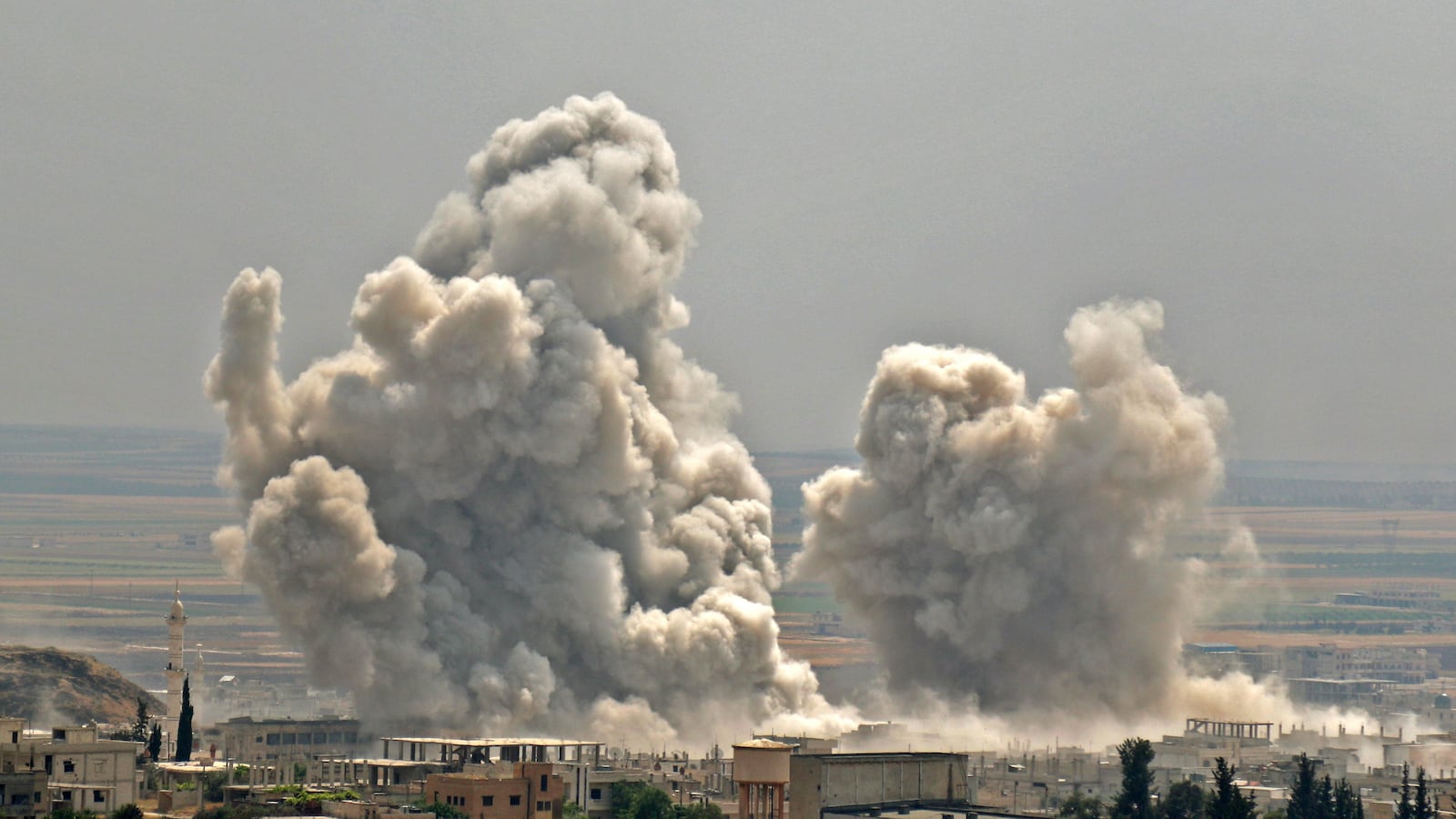GAZIANTEP, Turkey—Syrian activists report that the Assad regime has launched its most intense assault since the beginning of the war almost nine years ago. The target is Idlib, the last opposition holdout in northwestern Syria.
All indicators suggest that the campaign will produce a new humanitarian disaster and be the beginning of a final confrontation between the Syrian National Army (SNA)—an alliance of Turkish-backed armed opposition forces—and Russian-Iranian-backed pro-Assad units.
The fighting undermines the perception of a seamless Turkish-Russian rapprochement and reveals the hidden gridlock that exists even after years of negotiations over key issues that are critical to Turkey’s security and President Recep Tayyip Erdoğan’s political prospects.
The unbridgeable gap between Moscow and Ankara has created space for the United States to acquire more leverage in its relationship with Turkey by acting as a counterweight to Moscow’s ambitions, if the Trump administration chooses to do so.
“The situation here is shit,” says Abd al-Rahman al-Aissawi a local activist in the town of Mara’at al-Nu’aman, which has iconic status as a holdout against the regime. “In nine years of war, this is the worst bombing we’ve ever seen. This is worse than the regime’s assault on east Aleppo [in 2016]. At least then, we negotiated a way out. This time, there’s nowhere to go, we have to fight. The regime knows this, and is paving the way for a truly scorched earth.”
In addition to a stepped up Syrian-Russian air campaign, the war zone in Idlib looks further set to escalate due to increased involvement by powers with ties to the Syrian opposition, in particular Turkey and to a lesser extent the United States.
Since the most recent reboot of hostilities on January 16, SNA units reportedly received a new influx of American-made TOW anti-tank missiles that they used to repel regime advances around the town of Abu Jurayf, about 10 miles northeast of the rebel stronghold of Mara’at al-Nu’aman. (TOW stands for Tube launched, Optically tracked, Wire data link auto-guided missile.)
“We’ve since been able to take back the towns of Samaka, al-Barsa and Mushaymis and destroy a large number of regime firepower with the recent influx of TOW missiles,” says Abu Muhammad, a high ranking SNA commander. Rumors circulating at the time suggested that meetings held between Turkish defense officials and SNA leaders were attended by representatives from the United States as well.
Mustafa Sayjari, a prominent leader within the Turkish-backed Syrian National Army (SNA) fighting against regime forces in Idlib, has his own history of working with the United States. He told Syrian opposition television that he could confirm “via direct meetings I’ve had with the Americans, that Washington will support all Turkish efforts [with regards to Idlib].”
Expectations are that the U.S., Turkey and other western countries will take joint efforts to stave off a Syrian regime advance in order to prevent a new influx of refugees pouring across the Turkish border. As al-Aissawi noted Syrian displaced persons in Idlib have nowhere to flee in the event Idlib falls except to Turkey.
Throughout 2018, Idlib became the final refuge for an outpouring of SNA and opposition activists from key rebel strongholds in Homs, Damascus and the southern Dara’a province that fell to pro-Assad forces. Now, as the saying goes, “There’s no Idlib for Idlib.”
But the prospect of further refugees is one President Erdoğan is keen to avoid. Turkey’s assault on northeast Syria three months ago, in addition to removing the threat of U.S.-backed Kurdish forces along its border, was supposed to carve out a safe zone Ankara could use to relocate an unspecified percentage of Turkey’s 5 million Syrian refugees. The long-term presence of Syrian refugees in Turkey has recently stoked xenophobic sentiments in the country, with populists blaming them for Turkey’s recent economic downturn.
Last June, Erdoğan’s AK Party lost Istanbul in municipal elections for the first time since 2002. The defeat was seen as a major blow to Erdoğan personally that was partially brought about by the latter’s perceived lax stance towards refugees.
Shortly after coming to power, the opposition CHP party in Istanbul launched a new wave of arrests and deportations of Syrian refugees in a series of high profile cases that sparked outrage at home and abroad.
With these high stakes, Turkey has signaled that it takes the latest escalation by the Syrian regime of Bashar al-Assad very seriously. On Friday, sources told The Daily Beast, Erdoğan convened a closed meeting with Turkish intelligence chief Hakan Fidan and high-ranking SNA commanders declaring that ongoing Turkish attempts since July 2018 to reach a political solution with Russia over the status of Idlib had reached an impasse.
“Erdoğan called in to the meeting convened with Hakan Fidan, effectively telling us that the political process in Syria was over,” claimed SNA commander Abu Muhammad, who attended the meeting. “The President advised us to make final preparations to take a final stand and defend ourselves, giving assurances as well that Turkey would not abandon the SNA.”
The arrival of TOW missiles and Erdoğan’s acknowledgement of the failure of more than a year and a half of talks could signal a potential shakeup in the much-touted Turkish-Russian rapprochement that since 2015 has seen both countries significantly expand cooperation in the defense and energy sectors.
This also occurs nearly two weeks after news that Ankara sent 2,000 SNA fighters and an unspecified number of Turkish troops to the Libyan capital of Tripoli to halt the advance of Russian-backed rebel general Khalifa Haftar against the beleaguered Turkish-backed Libyan government of Fayez al-Sarraj.
After years of seeking common ground, in recent weeks Turkey finally appears willing to get tougher on Moscow. But the lengths to which Ankara is willing to go actually to hold off the regime advance in Idlib remain in question.
Over the weekend, the tide on the battlefield appears to have turned once again, with regime forces and their Russian and Iranian allies unleashing an unprecedented wave of bombing and advancing to Wadi Dayf, a town directly adjacent to and on the outskirts of Mara’at al-Nu’aman. Russian, Iranian and pro-Assad forces are said to be mobilizing for a renewed push on the outskirts of the city that will begin within days.
The widespread presence throughout Idlib province of Ha’it Tahrir al-Sham (HTS), the former al-Qaeda affiliate previously known as Jabhat al-Nusra, provides a convenient pretext for the Russian and Iranian assault, and hobbles the American ability to intervene more directly.
If Mara’at al-Nu’aman falls, it would represent the third major victory for regime forces in Idlib in the last six months, following the December 25 fall of Jarjanaz, and the capture on August 22 of Khan Sheikhoun (photo above was taken during that assault). Khan Sheikhoun was the site of the regime’s chemical attack in April 2017 that prompted U.S. airstrikes on the Syrian Shayrat airbase.
The prospect of such a fall, for now, appears plausible. “Other than the TOW missiles, the situation on the ground is the same as it was before, we haven’t received any new support from our allies,” claimed Abu Muhammad.
When asked on television about the SNA’s ability to repel further regime advances, SNA leader Mustafa al-Sayjari made sure to say, “We’re confident that keeping the city of Idlib in the hands of the opposition isn’t just a Syrian priority, but a Turkish one as well.”
The city of Idlib, located nearly 30 miles north of Mara’at al-Nu’aman, is the main population center in the rebel held province of the same name, and for now remains largely outside the scope of regime attacks. But Sayhari’s omission of the names of the frontline towns that are threatened by the regime was ominous.
Lastly, the heavy presence of Iranian-backed militias on the front lines in Idlib suggests that Tehran’s projection throughout the region has not been scaled back since Trump's January 2 assassination of Quds Force commander Qassem Soleimani. Many suspect that the U.S. strikes may in fact be pushing Tehran to assert itself further in order to avoid appearing weak.
Although Russia is believed to hold the upper hand in military decisions on the ground in Syria, the significance of Iranian forces cannot be overstated: the Russians attempts on their own to advance on Idlib throughout 2018 and early 2019 fell short and failed to achieve any major successes. The fall of Khan Sheikhoun in late August 2019 was largely made possible by the arrival of a large contingent of Iranian-backed forces following new power sharing agreements between Tehran and Moscow on the frontlines. Now, Iranian backed Lebanese Hezbollah and Afghan Fatimiyun Shi’a militias are the shock troops leading the assault on Mara’at al-Nu’aman under the cover of Russian air power.
Sitting in a small operations room in a town outside Mara’at al-Nua’man, activist Abd al-Rahman al-Aissawi combs through a database of enemy military communications between Afghans speaking Dari that have been intercepted and leaked in real time by Turkish-backed SNA forces. Unfortunately, neither he nor anyone else can do much with them. In a last ditch effort on social media, he sends out a blast to anyone willing to listen, “Does anyone speak or know anyone who speaks Afghan? We need translators in Idlib; are willing to pay money.”
As The Daily Beast went to press, he had failed to get any responses.







